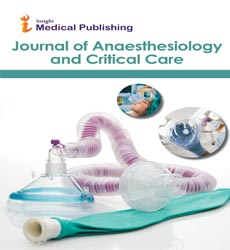The Critical Care General Anaesthesia Syllabus Describes How to use Critical Care Physicians to Give Anaesthesia and Increase Surgical Caseload in Difficult Situations.
Mark Walsh*
Department of Anesthesiology, University of California, USA
- *Corresponding Author:
- Mark Walsh
Department of Anesthesiology, University of California, USA
E-mail: markwalsh@gmail.com
Received Date: September 13, 2021; Accepted Date: September 17, 2021; Published Date: September 22, 2021
Citation: Walsh M (2021) The Critical Care General Anaesthesia Syllabus Describes How to use Critical Care Physicians to Give Anaesthesia and Increase Surgical Caseload in Difficult Situations. J Anaesthesiol Crit Car. Vol.4 No.1:02
Editorial
Anesthesiologists and other specialised physicians are in short supply all across the world, not just in Haiti. Five billion people, mostly in LMICs, lack consistent access to safe and cheap surgical and anaesthetic care. The lack of access to safe anaesthesia is a major hurdle to surgical treatments in many circumstances. Multiple studies from low- and middle-income countries, for example, found anesthesia-mortality rates ranging from 1 death per 133 anaesthetic cases in Togo 1 death per 482 anaesthetic cases in Zimbabwe or 1 death per 504 anaesthetics in Malawi while a report from the United Kingdom stated that anaesthesia mortality was 1 death per 18500 anaesthetic cases. The majority of these investigations stated that a shortage of medically qualified anaesthetists, inadequate training and supervision for non-anesthetists, and a lack of equipment and supplies were to blame for the high mortality per anaesthetic case . According to the Lancet Commission on Global Surgery, 143 million extra surgical procedures are required each year to save lives with up to 5000 unmet surgical cases per 100,000 people in several regions . According to a survey conducted in Uganda, only 23% of anaesthetists had suitable facilities to provide safe anaesthesia for adult surgery, and only 13% could properly provide anaesthesia to children.
We believe that critical care physicians (CCPs) who have been trained as anesthesiologist-extenders and who work under the supervision of an anesthesiologist can fill this gap. CCPs are trained in advanced airway management techniques such as mask ventilation and endotracheal intubation. They are conversant with standard monitoring equipment as well as analgesics, sedative hypnotics, and paralytics, which are all utilised in the operating room. They are qualified to offer anaesthetic care because of these abilities. Despite the fact that our sample size was insufficient to statistically report complications and adverse events, all of the case loads throughout the mission were outpatient cases, which have been linked to reduced rates of adverse events lowering the risk of adverse events. Furthermore, as required by the training core competencies of critical care medicine, critical care physicians are trained and specialised in the care of peri-operative critically sick patients.
After inducing spinal anaesthesia, which has been found to be more cost-effective than general anaesthesia for hysterectomy the surgical mission group conducted 23 percent of the surgeries. CCPs can efficiently manage spinal anaesthesia for surgical surgeries below the umbilicus. Patients are moderately sedated during surgery after bupivacaine, with or without fentanyl, is injected into the intrathecal space through lumbar puncture. The scope of practise and skill set of CCPs includes both lumbar puncture and mild sedation. They allow the supervising anesthesiologist to focus more on patients having general anaesthesia.
This prospective pilot study found that CCPs can effectively provide anaesthesia under the supervision of a board-certified anesthesiologist in resource-constrained settings, filling the hole caused by a shortage of qualified anesthesiologists. To identify the scope of CCPs' participation in anaesthesia in these conditions, more research is needed. Following the CC GAS curriculum, a critical care physician can learn the fundamentals of general and spinal anaesthesia, allowing surgical mission teams to do more procedures in resource-constrained environments. To corroborate our findings, more research is needed, particularly to quantify the safety profile.
Open Access Journals
- Aquaculture & Veterinary Science
- Chemistry & Chemical Sciences
- Clinical Sciences
- Engineering
- General Science
- Genetics & Molecular Biology
- Health Care & Nursing
- Immunology & Microbiology
- Materials Science
- Mathematics & Physics
- Medical Sciences
- Neurology & Psychiatry
- Oncology & Cancer Science
- Pharmaceutical Sciences
